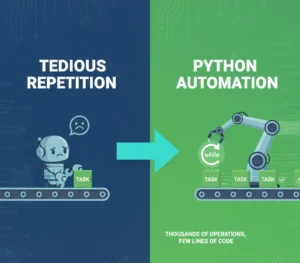Have you ever created a Python class and later needed to control how its data is changed or viewed? Maybe you wanted to add a check before updating a value or format an output in a specific way. If you’ve faced this, you’ve encountered the exact problem that getters and setters are designed to solve.
In this guide, we will demystify these fundamental concepts of object-oriented programming (OOP). You’ll learn what getters and setters are, why they are crucial for writing robust code, and how to implement them in your Python classes. By the end, you’ll be able to use these methods to protect and manage your object’s data like a pro.
What Are Getters and Setters?
At their core, getters and setters are special instance methods in a class that provide controlled access to its attributes (instance variables).
- Getters (Accessor Methods): These methods “get” or fetch the current value of an instance variable. They do not modify the data; they simply return it. Because their primary job is to access data, they are also known as Accessor Methods.
- Setters (Mutator Methods): These methods “set” or update the value of an instance variable to a new value. Since they change (or “mutate”) the internal state of an object, they are formally called Mutator Methods.
Think of it like your bank account. You don’t directly interact with the cash in the vault. Instead, you use an ATM or app (a getter) to check your balance and a transfer function (a setter) to deposit or withdraw funds. This layer of control allows the bank to enforce rules, like ensuring you can’t withdraw more than you have.
A Practical Example: The Bank Account Class
Let’s bring this to life with a classic example: a BankAccount class. We’ll start with a basic version and then enhance it with proper getters and setters.
First, let’s create the class with a constructor to set the initial balance.
class BankAccount:
# The Constructor - initializes the instance variable
def __init__(self, balance):
self.balance = balance # This line sets the initial balance
# A simple method to display the balance
def display(self):
print(f"Current Balance: ${self.balance}")
# Creating an instance of BankAccount
account1 = BankAccount(5000)
account1.display() # Output: Current Balance: $5000In this simple setup, the __init__ constructor acts as an initial setter, and display is a basic way to access the value. But we can do better.
Creating a Dedicated Setter Method
What if we want to change the balance after the account is created? We could directly change account1.balance = 8000, but this bypasses any control. A dedicated setter method gives us that control.
Let’s add a setBalance method.
class BankAccount:
def __init__(self, balance):
self.balance = balance
def display(self):
print(f"Current Balance: ${self.balance}")
# The Setter Method (Mutator)
def setBalance(self, new_balance):
self.balance = new_balance # Modifies the instance variable
# Using the setter
account1 = BankAccount(5000)
account1.display() # Output: Current Balance: $5000
account1.setBalance(8000) # Using the setter to change the value
account1.display() # Output: Current Balance: $8000Now, we have a controlled way to update the balance. The setBalance method is our mutator.
Creating a Dedicated Getter Method
Instead of a display method that just prints, a getter method returns the value. This is more flexible because it allows us to use the value elsewhere in our code, not just print it.
Let’s create a getBalance getter.
class BankAccount:
def __init__(self, balance):
self.balance = balance
# The Getter Method (Accessor)
def getBalance(self):
return self.balance # Returns the value instead of printing it
def setBalance(self, new_balance):
self.balance = new_balance
account1 = BankAccount(5000)
# Using the getter to access the value
current_balance = account1.getBalance()
print(f"The account balance is: ${current_balance}") # Output: The account balance is: $5000
account1.setBalance(8000)
print(f"The new balance is: ${account1.getBalance()}") # Output: The new balance is: $8000With getBalance, we can now retrieve the value and use it in calculations, store it in a variable, or print it with a custom message. This is the power of an accessor method.
The Power of Setters: Dynamic Instance Creation
An interesting feature of setters in Python is that they can create instance variables on the fly, even without a constructor.
class BankAccount:
# This class has no constructor!
def setBalance(self, new_balance):
# This setter CREATES the 'balance' variable when first called
self.balance = new_balance
def getBalance(self):
return self.balance
# Create an account without an initial balance
account2 = BankAccount()
# The setter method creates the 'balance' variable
account2.setBalance(3000)
print(account2.getBalance()) # Output: 3000In this example, the setBalance method is responsible for both creating and modifying the balance attribute. This demonstrates that you don’t always have to define all variables in the constructor; setters provide flexibility for dynamic object structures.
Ready to Go from Basics to Pro?
Mastering getters and setters is a key step on your journey to becoming a proficient Python programmer. They form the foundation for more advanced concepts like properties and data validation, which are essential for building complex, real-world applications. If you’re ready to move beyond the basics and build a comprehensive skill set with structured guidance and hands-on projects, we have the perfect path for you.
If you’re serious about mastering Python, check out our pre-recorded python comprehensive video course.
Conclusion
In this post, you’ve learned that getters (accessors) and setters (mutators) are essential tools for controlled data access in your Python classes. Getters allow you to safely retrieve values, while setters let you modify them, with the added power to create instance variables dynamically. By adopting these practices, you write more maintainable, flexible, and professional code. Keep practicing by adding getters and setters to your own classes, and you’ll quickly see the benefits.
Common Questions About Getters and Setters
What’s the difference between a getter and a regular method that returns a value?
There is no syntactic difference; a getter is a method that returns a value. The distinction is in its purpose and naming convention. A getter’s specific role is to return the value of a single, specific attribute, and it’s often named get_VariableName to make its purpose clear.
Why use a getter/setter instead of directly accessing the attribute?
Using object.attribute is fine for simple scripts. However, getters and setters become crucial when you need to add logic. For example, a setter can validate data (e.g., “is this a positive number for a balance?”) or log changes. Using methods from the start makes your code easier to extend and debug later.
Are there more “Pythonic” ways to implement getters and setters?
Yes! Python has a built-in property decorator that allows you to define getters, setters, and deleters in a way that lets you still use the simple object.attribute syntax. This is often the recommended next step after understanding the basic concept of getters and setters covered here.














